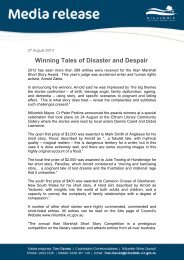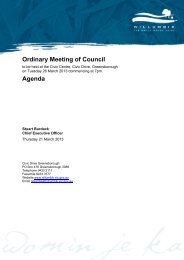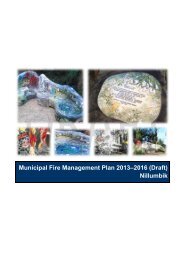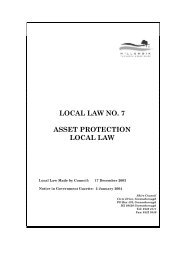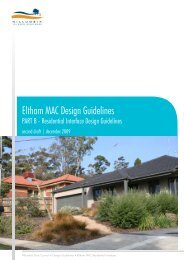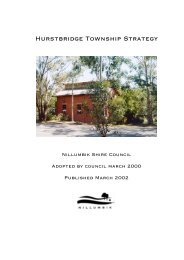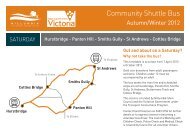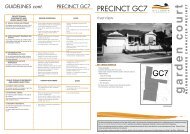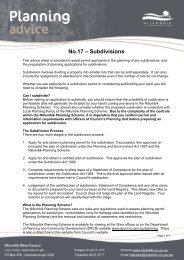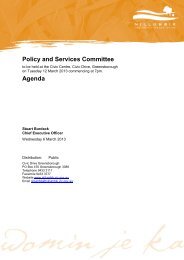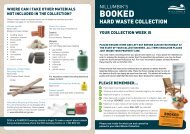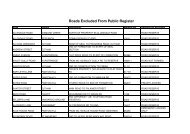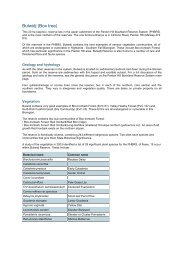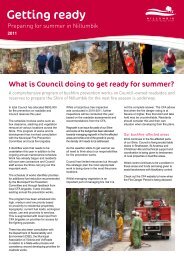Sustainable Water Management Plan - Nillumbik Shire Council
Sustainable Water Management Plan - Nillumbik Shire Council
Sustainable Water Management Plan - Nillumbik Shire Council
Create successful ePaper yourself
Turn your PDF publications into a flip-book with our unique Google optimized e-Paper software.
Indicators<br />
<strong>Water</strong> conservation performance indicators and targets have been set to measure the success of each<br />
initiative. Each indicator is directly linked to an objective, and targets have been set for 2010-2011. In order to<br />
measure the success of actions, <strong>Council</strong> will benchmark data annually against baseline data to illustrate the<br />
progress made in reducing water demand.<br />
The indicators and targets for Theme 1: <strong>Water</strong> conservation are as follows:<br />
Indicators Target for 2010-2011<br />
Reduction in annual water consumption (kL) <strong>Council</strong> – 45% decrease from 2000-2001<br />
consumption rate<br />
Community – 25% decrease from 2000-2001<br />
consumption rate<br />
Amount of water reused annually (kL)<br />
Uptake of rainwater harvesting opportunities (kL)<br />
Amount of AAA rated water appliances installed<br />
Amount of education and awareness raising<br />
materials available to staff and the community<br />
Base year<br />
The year 2000-2001 was selected as the base year<br />
for water consumption figures as it is the earliest<br />
year that a reliable set of data was available to<br />
<strong>Council</strong>, showing ‘business as usual’ without water<br />
restrictions or permanent water saving rules. The<br />
baseline data highlights the relative reticulated water<br />
demand across <strong>Council</strong>’s assets and operations.<br />
When comparing rainfall over the past five years,<br />
the base year was the wettest and therefore it is<br />
assumed that any reduction in water use over the<br />
following drier years is due to water saving initiatives<br />
<strong>Council</strong> has undertaken and influence from staged<br />
water restrictions.<br />
Rainfall<br />
In response to low annual rainfall, <strong>Council</strong> and the<br />
community may need to increase irrigation rates for<br />
the maintenance of playing surfaces. It is therefore<br />
expected that lower rainfall could lead to <strong>Council</strong> and<br />
the community consuming more water.<br />
Table 1: Average annual rainfall in <strong>Nillumbik</strong><br />
Increase<br />
Increase<br />
Increase<br />
Increase<br />
As rainfall and climate variations affect water<br />
consumption, it is important to set long term targets<br />
to absorb these annual variations. Rainfall data for<br />
the past six years reflects the current drought and<br />
is not intended to reflect climate change, which<br />
requires longer-term analysis and consideration.<br />
Future <strong>Council</strong> water consumption<br />
If no water saving actions are undertaken, <strong>Council</strong>’s<br />
future water consumption may slightly increase due<br />
to the acquisition of water consuming operations,<br />
such as installation of additional irrigation systems or<br />
establishment of new open space. The development<br />
or upgrade of <strong>Council</strong> owned buildings may also<br />
increase water consumption during construction<br />
and operation. However, it is expected all future<br />
developments will include water efficient features<br />
resulting in reduced water demand over time.<br />
Projected population growth from 2006 to 2011 is<br />
anticipated to be approximately 3%. 6 This slight<br />
increase in population is not expected to have a<br />
significant impact on <strong>Council</strong>’s services that would<br />
result in increased water use.<br />
2000-01 2001-02 2002-03 2003-04 2004-05 2005-06<br />
771.1 mm 630.4 mm 424.4 mm 683.6 mm 789.6 mm 716.5 mm<br />
Rainfall monitoring stations located at Yan Yean and Warrandyte (Source: Bureau of Meteorology)<br />
<strong>Water</strong> consumption (corporate)<br />
A reticulated water consumption inventory was<br />
undertaken for all of <strong>Council</strong>’s facilities for the<br />
financial years 2000-2001 to 2005-2006. (See<br />
Appendix A) Reticulated water consumption data<br />
was provided by Yarra Valley <strong>Water</strong>.<br />
The results from this inventory have provided the<br />
strategic direction for the development of the <strong>Plan</strong>.<br />
This data provides <strong>Council</strong> with an understanding<br />
of the many issues surrounding reticulated water<br />
use within its own operations and throughout<br />
the community, and highlights the importance of<br />
comprehensive data and information management.<br />
The inventory did not consider other water supplies<br />
such as creek water, bore water, recycled water,<br />
rainwater or greywater.<br />
Over the past five years, <strong>Council</strong> has achieved a<br />
35% reduction in its water use. This reduction can be<br />
attributed to a range of water saving initiatives which<br />
have been implemented by <strong>Council</strong> and through the<br />
introduction of mandatory water restrictions.<br />
Determining water demand<br />
A water consumption inventory for <strong>Council</strong>’s<br />
operations was completed in 2005. The data has<br />
been categorised according to ICLEI property types<br />
to allow for ease in comparison of usage between<br />
<strong>Council</strong>-owned facilities and properties (Appendix<br />
C). This data allows <strong>Council</strong> to easily determine<br />
its highest water-using facilities and where water<br />
efficiency measures can be best implemented.<br />
The inventory of <strong>Council</strong>’s water consumption<br />
highlights that <strong>Council</strong> has significantly decreased<br />
its reticulated water consumption over the past<br />
five years by a total of 64,003 kilolitres or 35%<br />
(Graph 2). The reduction over the past several<br />
years can be attributed to the introduction of staged<br />
water restrictions (November 2001) and <strong>Council</strong>funded<br />
initiatives to reduce water use such as the<br />
installation of warm season grass species on some<br />
playing fields and a reduction in the area of irrigated<br />
open space (Appendix D).<br />
Graph 2: <strong>Council</strong>’s annual water consumption<br />
and costs vs rainfall<br />
Consumption (kL) and cost<br />
250000<br />
200000<br />
150000<br />
100000<br />
5000<br />
0<br />
<strong>Council</strong>’s annual water use and costs vs rainfall<br />
2000-01 2001-02 2002-03 2003-04 2004-05 2005-06<br />
consumption cost rainfall<br />
(Data Source: Yarra Valley <strong>Water</strong> and Bureau of Meteorology)<br />
Graph 2 details <strong>Council</strong>’s water use and associated<br />
costs over the past five years in comparison to<br />
annual rainfall. With the exception of 2000-2001, the<br />
graph clearly shows the relationship between annual<br />
rainfall and water usage rates. As expected, there<br />
is a relationship between low annual rainfall and<br />
increased irrigation.<br />
900<br />
800<br />
700<br />
600<br />
500<br />
400<br />
300<br />
200<br />
100<br />
0<br />
Rainfall (mm)<br />
6<br />
<strong>Nillumbik</strong> <strong>Shire</strong> <strong>Council</strong> – <strong>Council</strong> <strong>Plan</strong> 2007-2011<br />
14 <strong>Sustainable</strong> <strong>Water</strong> <strong>Management</strong> <strong>Plan</strong> <strong>Sustainable</strong> <strong>Water</strong> <strong>Management</strong> <strong>Plan</strong>



